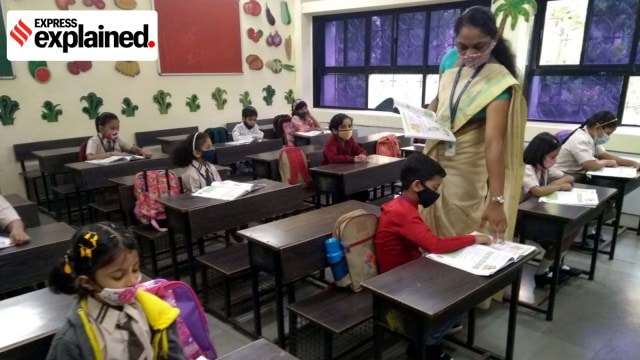Explained: The debate over appropriate age of admission to Class 1
There are wide variations in the age criteria among states when it comes to admission to Class 1. There were 14 States and Union Territories, as of March 2022, that allow Class 1 admission for children who have not completed six years.
 The new NEP pitches for a “5+3+3+4” design for formal schooling corresponding to the age groups 3-8 years (foundational stage), 8-11 years (preparatory stage), 11-14 years (middle stage), and 14-18 years (secondary stage). (Photo: Express photo by Deepak Joshi)
The new NEP pitches for a “5+3+3+4” design for formal schooling corresponding to the age groups 3-8 years (foundational stage), 8-11 years (preparatory stage), 11-14 years (middle stage), and 14-18 years (secondary stage). (Photo: Express photo by Deepak Joshi) Schools in Delhi this year will continue to admit students to Class 1 below the age of 6 years. This is contrary to recent letters from the Union government to all states, urging them to align the age of entry to Class 1 with the new National Education Policy 2020.
According to a response furnished by the Union government in the Lok Sabha in March 2022, there are wide variations in the age criteria among states when it comes to admission to Class 1. There were 14 States and Union Territories, as of March 2022, that allow Class 1 admission for children who have not completed six years.
What age is appropriate for children to begin formal education and why is it important? We explain.
What does the NEP 2020 say about the minimum age to admit students in Class 1?
The new NEP pitches for a “5+3+3+4” design for formal schooling corresponding to the age groups 3-8 years (foundational stage), 8-11 years (preparatory stage), 11-14 years (middle stage), and 14-18 years (secondary stage). This brings early childhood education (also known as pre-school education for children of ages 3 to 5 years) under the ambit of formal schooling. This effectively means that a child should be 6 years old to be eligible for admission into Class 1, after completing three years of early childhood education.
So why is it in the news now?
Since the launch of NEP 2020, the Union Education Ministry has been writing to the States and Union Territories, urging them to “align” their age for admission to Class 1 at six years, in accordance with the new national education policy. Given that the age of entry varies across states — some admit students to Class 1 after reaching the age of 5, while others admit at 6 years — whenever the Centre issues a reminder emphasising the NEP provision and its adherence, the matter gains attention in the news.
For instance, last year, when Kendriya Vidyalayas increased the age of admission from five to six years for Class 1 in an effort to sync with the recommendations of the NEP 2020, a group of parents challenged this decision in court. They argued that the change was introduced suddenly, just before the admission process was set to begin in February 2022. The Delhi High Court ultimately dismissed their plea, and this decision was later upheld by the Supreme Court.
This year, and until very recently, after the Education Ministry sent another reminder to the states regarding aligning the entry age, the Delhi government decided, at least for this academic year, to continue with its existing guidelines in accordance with the Delhi School Education Rules (DSEAR 1973), which permit admission to Class 1 below the age of 6 years.
What does the Right to Education (RTE) Act, 2009 say about the age of entry for Class 1?
The RTE Act guarantees education from the age of 6 years to 14 years. This means that a child is expected to begin elementary education (read: Class 1) at the age of 6 years. According to academicians who were associated with the drafting of the Right to Education law, the age of 6 years was identified considering the universal age that most countries across the world have been following, i.e. to admit a child into grade one at the age of 6 or 7.
Professor R Govinda, former Vice Chancellor of the National University of Educational Planning and Administration who was part of the drafting exercise told The Indian Express, “The age 6, which the RTE says is the age to begin Class 1, is simply a reiteration of what has already been a part of our Constitution. This was also the same in Gandhi’s idea of basic education and was also stated in the report of the Sargent Commission (on post-war education development in India), which goes back to the 1940s.”
RTE Act had to specify the entry age for enforcement of formal compulsory education which has been ignored even now by many States leading to the confusion of the actual age for admitting students grade1. In fact, most of the clauses in the RTE Act have remained unimplemented fully,” Govinda added.
What does research say about the entry age for formal education?
David Whitebread, from the Faculty of Education at Cambridge University in his paper titled ‘School starting age: the evidence’ explained why children may need more time to develop before their formal education begins in earnest.
In his research, Whitebread stated that “Studies have compared groups of children in New Zealand who started formal literacy lessons at ages 5 and 7. Their results show that the early introduction of formal learning approaches to literacy does not improve children’s reading development, and may be damaging. By the age of 11, there was no difference in reading ability level between the two groups, but the children who started at 5 developed less positive attitudes to reading and showed poorer text comprehension than those children who had started later. In a separate study of reading achievement in 15-year-olds across 55 countries, researchers showed that there was no significant association between reading achievement and school entry age.”
What is the age to start formal education across the world in various countries?
“Six is the standard age for starting primary school across East Asia, not just in Japan. This age is also common in most European countries. It is usual (though not compulsory) for younger children in these societies to attend some sort of preschool. In this regard, the USA and the UK, where children generally start school at 5, appear to be outliers,” said Latika Gupta, an Assistant Professor at the Department of Education, Delhi University.
Scandinavian countries, on the other hand, start at 7 because they have universal child care. The childcare aspect of schooling needs to be borne in mind. In England and the USA, childcare provision for under-5s is patchy and expensive, whereas in Scandinavia, care for the under-7s is universal and state-supported,” she added.
- 01
- 02
- 03
- 04
- 05






































